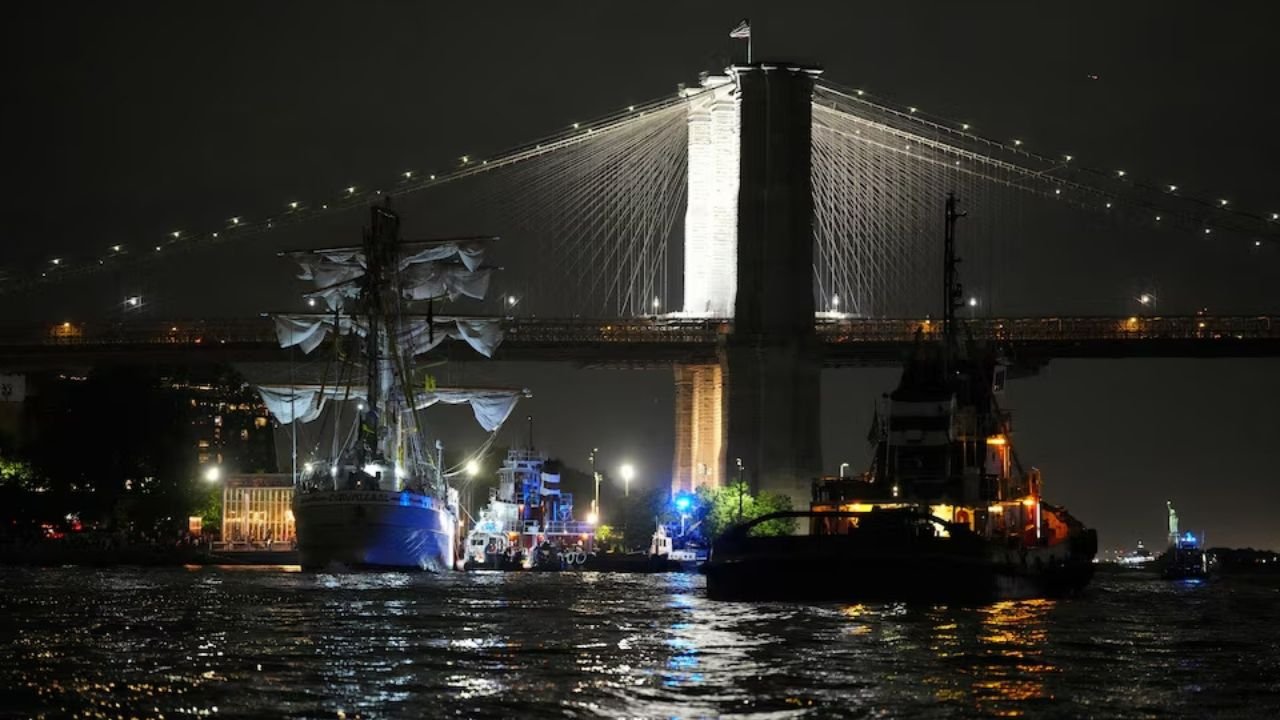NEW YORK, May 17 – A tragic maritime accident unfolded Saturday night when a tall ship belonging to the Mexican Navy collided with the iconic Brooklyn Bridge, resulting in the loss of two lives and injuries to at least 17 others. The training vessel, known as Cuauhtémoc, was illuminated with decorative lights and proudly displayed a massive Mexican flag as it made its way along the East River. But the festive scene turned chaotic when the ship’s towering masts struck the bridge’s steel framework, snapping off upon impact.
The incident occurred near the Manhattan side of the Brooklyn Bridge, a historic structure that has linked Manhattan and Brooklyn since its completion in 1883. The Cuauhtémoc, a majestic sailing vessel with masts reaching up to 147 feet in height, was simply too tall to safely clear the bridge’s lower arches at that location. As the ship moved forward, the masts were crushed under the bridge’s weight, sending debris tumbling onto the deck below and throwing passengers into a panic.
New York City Mayor Eric Adams confirmed early Sunday morning that two of the 277 individuals on board had died from their injuries. Another two remained in critical condition as of the latest reports. Most of those hurt suffered injuries within the ship’s structure, not from falling overboard. Naval cadets, many dressed in crisp white ceremonial uniforms, could be seen clinging to the broken rigging after the crash. Despite the severity of the incident, no one was reported to have fallen into the river.
The Mexican Navy issued a public update following the collision, reporting that 22 people had sustained injuries aboard the vessel. Of those, 19 were receiving treatment in nearby hospitals, and three were described as being in serious condition. Emergency services arrived quickly at the scene, but according to officials, no search-and-rescue operations were necessary as all the injured were located and treated aboard or shortly after disembarkation.
According to a police official familiar with the investigation, preliminary analysis suggests that mechanical issues may have played a role in the mishap, though specific details have not yet been released. The Cuauhtémoc had been scheduled to depart New York for Iceland as part of a larger international voyage, and it’s unclear whether navigational systems or structural issues contributed to the collision.
Bystanders near the South Street Seaport, located just below the bridge, captured dramatic footage as the ship approached the span. In one video, people can be seen running away in fear as the towering vessel scraped violently against the bridge before veering toward the docks. While the scene was harrowing, transportation officials later announced that the bridge had not sustained any major structural damage. After a swift inspection, traffic on the bridge resumed in both directions.
The ship, named after Cuauhtémoc, the last emperor of the Aztecs, has long served as a training platform for naval cadets. Built in 1981 at the Celaya Shipyards in Bilbao, Spain, the Cuauhtémoc has visited ports across the globe as a symbol of Mexico’s maritime heritage. This particular visit to New York had been marked by a series of public events and tours, allowing visitors to step aboard and learn about the ship’s history and role in naval training.
As part of its New York visit, the Cuauhtémoc had been co-hosted by local maritime institutions, including the South Street Seaport Museum. The ship had been scheduled to conclude its public events on Saturday evening, just hours before the ill-fated departure.
Mexico’s foreign ministry issued a statement following the crash, noting that its ambassador to the United States and other diplomatic officials were actively engaged in supporting the affected cadets. They also confirmed that communication with New York authorities was ongoing as investigations continue.
In the aftermath, there is growing concern about the navigational protocols used during the ship’s departure. While tall ships have occasionally visited New York in the past, strict coordination with local maritime and bridge authorities is typically required to ensure safe passage. Whether such coordination was adequately carried out in this case is now part of the investigation.
The Brooklyn Bridge, a treasured landmark of New York City, stands not only as a functional structure but also as a symbol of the city’s enduring spirit. Saturday’s tragedy has raised questions about how such an incident could occur in one of the most monitored and regulated waterways in the world.
As the investigation proceeds, the thoughts of many remain with the victims and their families, as well as the cadets and crew who now face the emotional toll of this devastating event.

